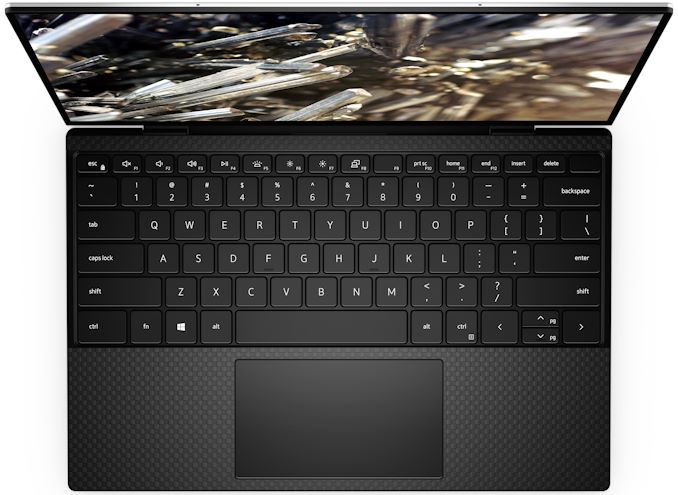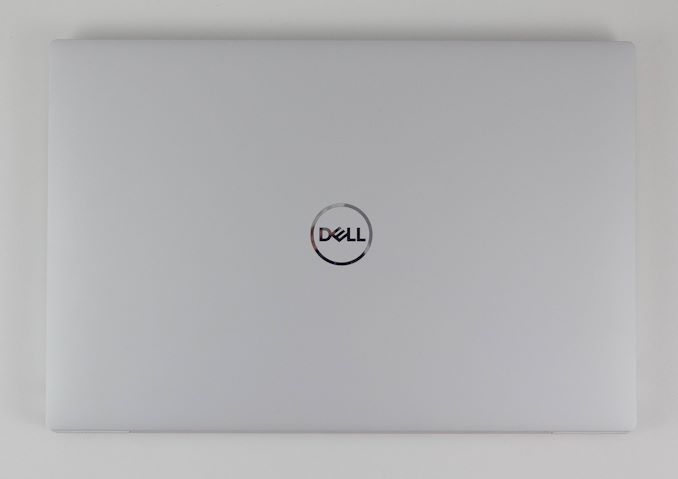The Dell XPS 13 (9300) Review: Return of the King
by Brett Howse on July 16, 2020 10:00 AM ESTDesign
Dell pioneered the thin-bezel laptop, but that does not mean they did not have room to improve on their original design over the years. The first several generations featured a webcam at the bottom of the panel, which was flattering to no one. With the proliferation of video chat, such a decision would be a major negative to many people. But thankfully Dell solved that particular issue a couple of generations ago, and the new model continues to pack a 720p webcam in the correct location above the display, with only a slightly taller top display bezel to accommodate the camera. And speaking of the display bezel, Dell has tweaked their design language slightly over the XPS 13 2-in-1, with both the black and white models both featuring a black display bezel on the clamshell XPS 13, which helps it disappear into the background a bit easier than the white bezel on the 2-in-1.

The XPS 13 in Platinum Silver with black carbon fiber
Another nice change over the 2-in-1 version is that Dell is not using their MagLev keyboard design, instead outfitting the XPS 13 with a more traditional scissor-switch keyboard with 1.0 mm of travel. The MagLev has a very short throw, whereas I find the traditional keyboard to be much more reassuring to use.
Dell is offering the XPS 13 in the same color choices as the 2-in-1 as well. The Platinum Silver model features a black carbon fiber keyboard deck with a soft-touch coating, while the Arctic White model features a woven fiber keyboard deck which Dell has treated with a stain and UV resistant coating, to prevent the deck from yellowing with age. The Arctic White is only $49 more, and certainly makes a statement, although it still suffers from the same issue as all white-on-white laptops with white backlighting, which is that the keyboard backlighting can wash out the keys in a bright room. That is a fairly minor negative though, for an otherwise fantastic finish.
The XPS 13 also features an excellent trackpad, offering a very smooth finish, and good precision. Laptop trackpads have come a long way, and part of that is the standardization on the Microsoft Precision touchpad drivers, which Dell employs here.
Dell has eschewed the use of USB Type-A ports, instead offering just a single USB Type-C port on each side of the laptop. This in turn is paired with a 3.5 mm headset jack on the right, and a micro SD card reader on the left. Although the XPS 13 lacks ports in numbers, it somewhat makes up for that with both USB ports supporting Thunderbolt 3, including power delivery. It is unfortunate that the Type-C port has found itself to be so confusing in its capabilities, but with the XPS 13 supporting the full range of protocols, as well as four lanes of PCIe on both ports, that at least is not a liability here. Dell does include a Type-C to Type-A adapter in the box as well, for those that require the larger port. By including power delivery on both sides of the laptop, that also means the XPS 13 can charge on either side, which can be very handy when moving the laptop from place to place.
Dell’s design ethos with their XPS lineup has converged across the entire range of XPS laptops, and with great success. The CNC milled aluminum bodies, thin bezels, compact designs, and lightweight chassis make for some of the most compelling devices in the industry. Moving to a 16:10 aspect ration on their XPS line has been yet another design win for Dell, and helps provide the excellent 91.5% screen to body ratio found on this XPS 13 notebook by further shrinking the bottom bezel. Dell has sculpted a clean, sleek, and functional device, and while the rest of the industry has also adopted the thin-bezel design, Dell has really mastered it.













224 Comments
View All Comments
grant3 - Friday, July 17, 2020 - link
USB-A is sometimes useful sure, but aside from old flash drives, what do you -need- it for?Just spend the $30 on some USB-C cables to replace your USB-A cables. Yes it's in many ways a needless expense, but it can be justified as a minor price bump for people who are already spending $1400+ on a new laptop.
yeeeeman - Thursday, July 16, 2020 - link
Tigerlake has a lot of things to fix...Sahrin - Thursday, July 16, 2020 - link
No Ryzen 4000 series; it's obsolete on launch day.roldaxc - Thursday, July 16, 2020 - link
Soldered SSD? only two Type-C ports? Just get an X1 Carbon. All around a much more solid laptop, more reliable, much better keyboard, lots of ports and similar footprint.I wonder why it's not included in the device comparison in this article..
iq100 - Thursday, July 16, 2020 - link
I would never buy a Dell product.When the XPS 15 9560 was purchased with on site service, it took six attempts to get it to work.
Here are the parts replaced on just the last (sixth) attempt.
SERVICE REPORT
REPLACEMENT PARTS
No. Dell Part QTY Description Parts Retained by Customer
1 5R1JP 1 ASSY,CVR,BTM,W/BDG,9550 No
2 M0T6P 1 ASSY,PLMRST,W/FPR,80,9560 No
3 9TXK7 1 ADPT,AC,130W,DLTA,4.5,L6,V2,E5 No
4 RN699 1 ADPT,CON,VID,DNGL,DP2VGA,L No
5 64TM0 1 ASSY,CBL,DC-IN, 9550/5510 No
6 2JVNJ 1 CORD,PWR,125V,2.5A,1M,C5,E5,US No
7 5G0HC 1 ASSY,PWA,DTRBD,AUDIO,9560/5520 No
Old wounds, not healed only fester. I purchase two U3011s. Both suffered the same design defect. Dell replace one but NOT the other, claiming "it was their policy to replace only one". Go figure.
www.tinyurl.com/HellIsDell
svan1971 - Thursday, July 16, 2020 - link
The only thing it's missing is a Ryzen cpu as far as I can tell.lmcd - Thursday, July 16, 2020 - link
Every comment thread is AMD vs Intel. I'm here to represent VIA's amazing Nano product line featuring Isaiah cores. Fight the power. Pick VIA.Honestly dunno why everyone is screaming for retroactive design wins. That's just not how it works.
Jorgp2 - Thursday, July 16, 2020 - link
Especially since AMD seems to count gaming laptops and their many products on the same chassis.What's the point of having more design wins, if those designs push fewer units.
Spunjji - Friday, July 17, 2020 - link
You should really ask the people making the designs. They're the ones shooting their own products in the foot, year after year.Spunjji - Friday, July 17, 2020 - link
Of course that's not how it works, but that's a straw man.According to the habitual Intel stans on this page:
You can't expect AMD designs when AMD has markedly inferior products and Intel is executing well.
You can't expect AMD designs when AMD have released broadly competitive products and Intel has been executing poorly for a couple of years with no signs of improving any time soon.
You can't expect AMD designs when AMD have released markedly superior products and Intel have been dropping the ball for 4 years straight but will maybe have a competitive product *soon*.
So the question is: when can we ever expect AMD designs to be developed? When do we finally get the competition needed to keep prices reasonable on high-end products?
The answer you're giving is "I'm fine with never", which means your opinion isn't worth shit.